IDEX Online Research: 2012 Holiday Jewelry Sales: Ho-Hum-Hum
October 24, 12
(IDEX Online) – American jewelers can expect good, but not great, sales during the upcoming all-important 2012 holiday selling season of November and December. Overall, jewelry sales in the
Here are highlights of the 2012 Holiday Selling Season Forecast:
· Total
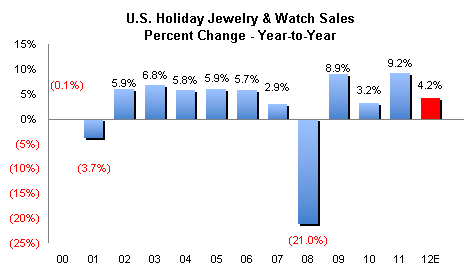 Source: US Dept of Commercce |
This year’s sales gain is below the consistent 5-6 percent gains that characterized most years in the early part of the past decade. The average holiday sales gain for the past decade of 2.5 percent is skewed by the sharp 21 percent decline in 2008, and is not a meaningful comparison.
· Estimated jewelry sales of $19.7 billion will be a new record for the holiday period. The previous record, $19.5 billion, was set in 2007, just prior to the Great Recession of 2008-2009, as the graph below illustrates.
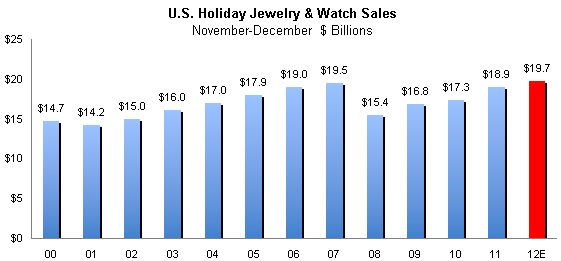 Source: US Dept of Commercce |
· Specialty jewelers’ holiday sales are expected to rise by about 3.8 percent, while jewelry sales at other merchants – mostly multi-line retailers like Wal-Mart, Costco, J.C. Penney, and others – are expected to rise by 4.4 percent.
The following graph summarizes specialty jewelers’ holiday sales gains since the year 2000.
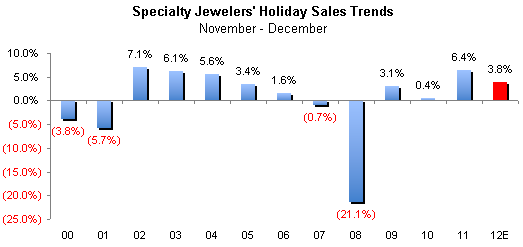 Source: US Dept of Commercce |
The following graph illustrates holiday sales gains for other merchants who sell jewelry. This group, which generated roughly 57 percent of total
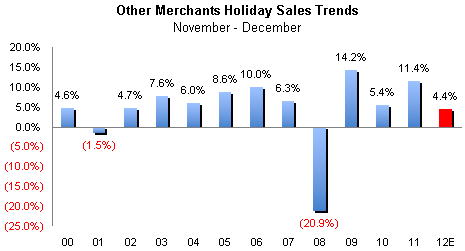 Source: US Dept of Commercce |
Specialty jewelers have been losing market share since the 1970s, a trend that is expected to continue. There are three reasons for this trend: 1) the total number of independent specialty jewelers has been shrinking; 2) other merchants have increased their emphasis on fine jewelry sales; and 3) specialty jewelers’ pricing credibility has been damaged by years of heavy discounting.
·
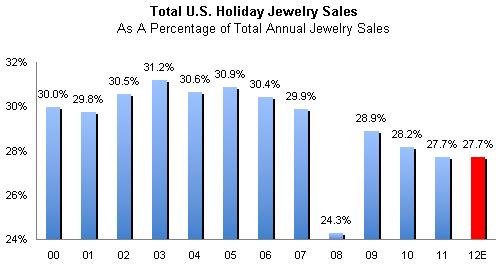 Source: US Dept of Commercce |
· The 4 percent sales gain is comprised of about 2 percent unit growth and about 2 percent inflation related to polished diamond prices as well as precious metals prices.
· Demand for fashion jewelry – multiple precious gemstones and precious metals – is expected to be stronger than demand for “traditional” jewelry such as diamond solitaires.
· While online jewelry sales growth is not reliably tracked during the holiday selling season, it is expected to grow at a slower rate this year than in prior years, mostly because the market is beginning to mature. Overall, online jewelry sales represent about 6 percent of total
Factors Affecting Consumer Demand During 2012
Positive Factors
· The
· Unemployment seems to be headed lower. When shoppers are worried about losing their job, they tighten their purse strings. With the job market stable – and perhaps improving slightly, depending on which figures you believe – consumers should be more willing to spend money in the 2012 holiday selling season.
· The presidential election will be over in early November. While there will be some lingering negative impact, especially as the losers lick their wounds, the uncertainty of the nation’s next president will be resolved. Retail sales generally return to a more normal level several weeks after a major election.
· Weather forecasts call for “near normal” cold. Cold snowy weather puts consumers in the holiday mood more quickly than warmer, unseasonal weather such as most of the nation experienced in 2011.
Negative Factors
· Competition for consumers’ spending will be especially intense this year, due primarily to many new electronic tablets that have retail price points in the range of jewelers’ average ticket ($200-500).
· There is lingering uncertainty about longer-term economic growth. The recession of 2008-2009 (which still feels like it is going on) has kept a damper on consumer spending.
· The consumer “Wealth Factor” remains uncertain. The housing market appears to have hit bottom and may be recovering in some markets. Stock market volatility continues to put fear in consumers’ retirement portfolios.
· Political instability in global hotspots – for example, the
· The possibility of a European recession is very real, and it could drag the
· Jewelry sales gains have been trending lower this year, partly due to weaker consumer demand and partly due to strong gains in 2011 (which makes this year’s percentage gains more difficult). The graph below illustrates recent weakening jewelry sales gains in 2012.
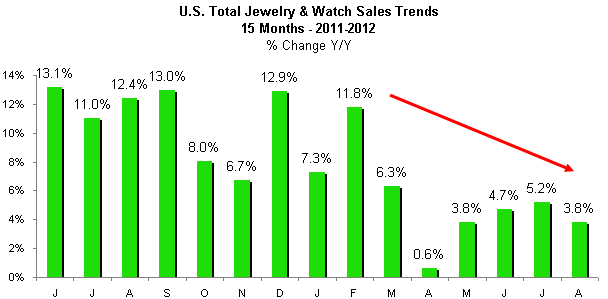 Source: US Dept of Commercce |
Glimpse of Jewelers’
There are several broad trends that are expected to characterize the 2012 Holiday Selling Season for
· The selling season will come later this year due to a high level of uncertainties. We are forecasting that December sales will show greater gains than November sales, despite especially difficult comparisons to last December (see graph above).
· The average jewelry ticket will remain below prior year levels simply because consumers have been spending less per purchase on jewelry since the 2008-2009 recession.
· Demand for fashion jewelry will be stronger than demand for “traditional” jewelry. Consumers want “flash” for cash; if they are going to spend significant money on an item, it needs to be evident to the public – friends and family. Fashion jewelry often carries a lower retail price per unit than more expensive fine jewelry; this will also contribute to the industry’s lower average ticket during the 2012 Holiday Selling Season.
· Store staffing levels will be a challenge. Less staff will likely be needed early in the season, but more staff will be required late in the season to make sure no shopper walks away empty-handed.
Non-Factor: Consumer Confidence
Astute readers will notice that we did not mention the Consumer Confidence Index as either a positive or a negative factor. The fact is this: Consumer Confidence is not a reliable predictor of consumer spending. As illogical as it may be, a study in late 2011 proved this (one again), and it noted that most credible forecasts for the economy and consumer spending either do not include the Consumer Confidence Index or minimize its impact on the forecast. IDEX Online Research ignores the Consumer Confidence Index in its forecasts.